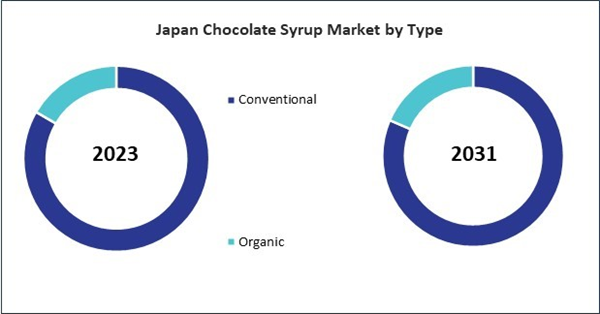In the B2B channel, chocolate syrup is sold to businesses such as restaurants, cafes, hotels, and catering services. This segment involves bulk purchases for use in commercial kitchens, where chocolate syrup is used as an ingredient in desserts, beverages, and other menu items. The B2B market is essential for foodservice providers that require large quantities of syrup at wholesale prices. Thus, 113.35 kilo tonnes of chocolate syrup is expected to be sold by B2B sales channel by 2031.
The China market dominated the Asia Pacific Chocolate Syrup Market by Country in 2023, and is expected to continue to be a dominant market till 2031; thereby, achieving a market value of $2.72 billion by 2031. The Japan market is registering a CAGR of 13.5% during 2024-2031. Additionally, the India market is expected to showcase a CAGR of 15% during 2024-2031.
One of the primary drivers of the chocolate syrup market’s growth is the increasing demand for indulgent food products. Consumers today are more drawn than ever to comfort foods and sweets that provide a sensory escape, and chocolate remains one of the most universally craved flavors.
Additionally, the growing demand for confectionery products, especially among younger generations, has led to a notable rise in the consumption of this. Ready-to-eat desserts, specialty beverages, and quick-fix treats that frequently contain chocolate syrup are more appealing to Millennials and Gen Z. Whether used as a topping for ice cream, drizzled over pancakes, or mixed into coffee and milkshakes, chocolate syrup’s versatility ensures its continued relevance in a market where convenience and indulgence are highly prized.
The demand for chocolate syrup in this region is driven by the expanding influence of Western culinary culture, urbanization, and rising disposable incomes. In China, the rising demand for chocolate syrup is largely fueled by the growing café culture in urban areas. According to the World Bank, China’s urban population reached 65% in 2023. Chinese consumers, particularly in major cities like Shanghai and Beijing, are increasingly frequenting cafés that offer Western-style beverages, including mochas, hot chocolates, and frappes that heavily feature chocolate syrup. The introduction of chocolate syrup to a broader audience has been facilitated by the proliferation of international and local coffee chains, including Starbucks and Luckin Coffee.
List of Key Companies Profiled
- Nestle S.A.
- The Hershey Company (Hershey Trust Company)
- The Kroger Co.
- The J.M Smucker Company
- R.Torre & Co. (Torani)
- Bosco Products, Inc.
- Hollander Chocolate, Inc.
- Walden Farms, LLC (PANOS Brands)
- Noushig, Inc. (Amoretti)
- Gold Pure Food Products Co., Inc.
Market Report Segmentation
By Distribution Channel (Volume, Kilo Tonnes, USD Billion, 2020-2031)- B2B
- B2C
- Hypermarkets/Supermarkets
- Convenience stores
- Specialty Stores
- Online
- Conventional
- Organic
- China
- Japan
- India
- South Korea
- Singapore
- Malaysia
- Rest of Asia Pacific
Table of Contents
Companies Mentioned
Some of the key companies profiled in this Asia Pacific Chocolate Syrup Market include:- Nestle S.A.
- The Hershey Company (Hershey Trust Company)
- The Kroger Co.
- The J.M Smucker Company
- R. Torre & Co. (Torani)
- Bosco Products, Inc.
- Hollander Chocolate, Inc.
- Walden Farms, LLC (PANOS Brands)
- Noushig, Inc. (Amoretti)
- Gold Pure Food Products Co., Inc.









